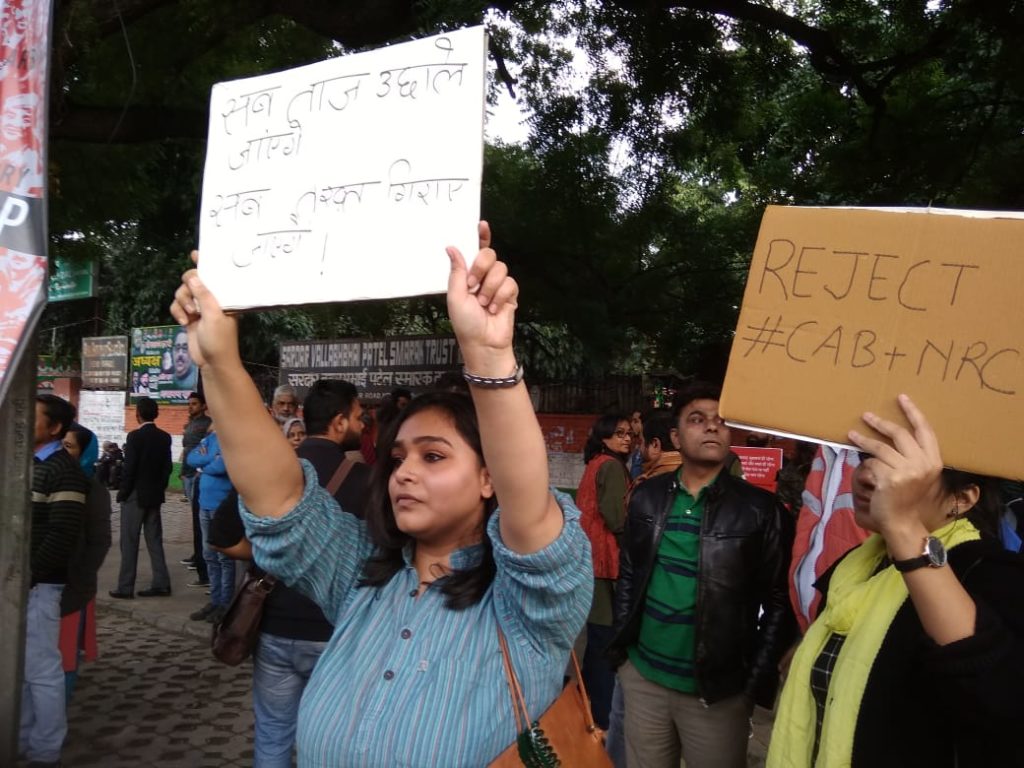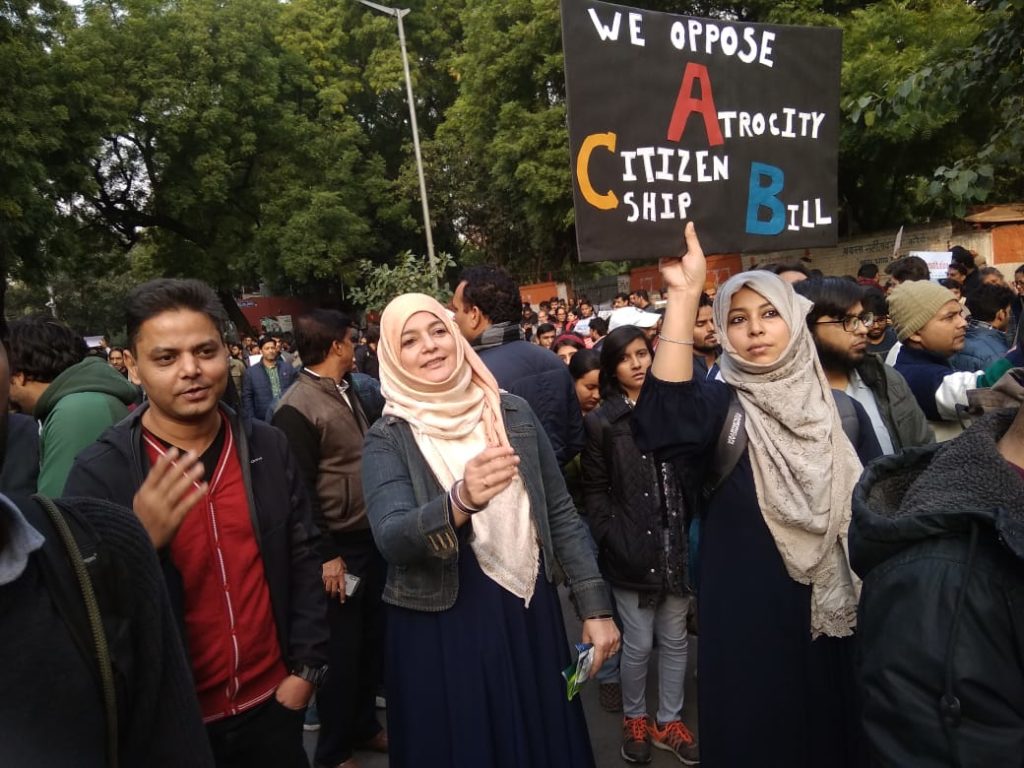After days of tense stand-off with angry students all over the country’s premier educational institutes over the Citizenship (Amendment) Act (CAA) that seriously undermines India’s secular Constitution, last Sunday, a belligerent Delhi Police entered the campus of Jamia Millia Islamia in Delhi without permission from the vice-chancellor or the authorities. They threw tear gas shells and stun bombs in the library and outside classrooms where the students were preparing for their examinations, violently chased and abused students — men and women — and beat many of them mercilessly.
Images of this wanton violence and resistance by students flooded TV news channels and social media, and continued late into the night. In an angry response, hundreds of students and teachers from JNU, Jamia and Delhi University, along with people from the civil society, laid a peaceful siege all night outside the Delhi Police Headquarters condemning the police violence and demanding its withdrawal from the campus.
Police had claimed that the students had taken to violence and thrown stones at them and burnt a few buses. Later, they denied that the buses were torched by the students, and blamed certain outsiders with ‘criminal’ backgrounds.
Prestigious foreign publications have reported how the debt-ridden owners of Indian companies are selling them cheap, while there is mass unemployment, and growth in both industry and agriculture has tanked. Many of these moneybags have been parking their funds in their foreign accounts, lest they are forced to flee the country.
Not far away from Delhi, in Aligarh, in another minority institution, Aligarh Muslim University (AMU), police in riot gear moved into the campus. Earlier, more than 30,000 students were sitting on a fast against the CAA, and there were daily massive militant protests. It was a repeat of what happened a few hours earlier in Delhi’s Jamia. Brutal baton charge accompanied by tear gas bombs sent panic amongst students preparing for their examinations. Scores were detained and roughed up by the police. Unlike in Jamia, the VC here seemed to have willfully invited the police inside the campus and made no effort to protest against their wanton brutality unleashed on peaceful students.
This show of force by the police provoked the first nation-wide protests against Prime Minister Narendra Modi, his Union Home Minister Amit Shah, and his government that got re-elected for a second term in May 2019. The entire opposition has united against the brutality on students. Priyanka Gandhi led a massive protest in a cold winter night at India Gate in Delhi. Tens of thousands of youngsters and students came out in protest in small and big towns all over India, many facing lathi-charges and jail. So much so, the Left and Congress, along with others, led a joint protest in Trivandrum, even while Mamata Banerjee herself led a massive march in Kolkata.
The loyalist sections of the Indian media might be playing complicit in hiding it, but the fact is that Modi presides over a rapidly collapsing economy that tanked due to his mindless decisions like the demonetisation of currency, flawed application of GST and raids by enforcement agencies against allegedly corrupt businesses. His neurosis about the conspiring Delhi elite has eroded trust in the economy — a fact eloquently and forcefully brought out in an article by an extremely critical former prime minister, Manmohan Singh.
Prestigious foreign publications have reported how the debt-ridden owners of Indian companies are selling them cheap, while there is mass unemployment, and growth in both industry and agriculture has tanked. Many of these moneybags have been parking their funds in their foreign accounts, lest they are forced to flee the country.
The Reserve Bank of India, which regulates banks in the country, has been forced to revise the rate of growth of GDP from a robust 7.6 per cent in February 2019 to 5.1 per cent in December 2019 — a fall of 2.5 per cent in 11 months alone. This slowdown caused by a demand squeeze was sought to be stemmed by a reduction of interest rates by RBI, but these measures have expectedly failed as most of the companies were carrying toxic assets that did not allow them to rise again on the productivity curve. All the concessions to the industry, hence, have been allegedly salted away in foreign accounts through hawala or other means.

Union Finance Minister Nirmala Sitharaman, whose transparent inadequacies are exacerbated by her arrogance, has failed to find a solution to the crisis. Since she became FM, she has presented three budgets, whereby, indeed, one was enough. Undoubtedly, she has been a total failure and it is as clear as daylight to all concerned, including beleaguered industrialists who dare not question the regime with the fear of retribution.
Stared at by this dark and depressing economic crisis, which could destroy the Indian dream of being a regional power, the demagogue that Modi is, began to give primacy to his time-tested agenda to make India a ‘Hindu State’ (Hindu Rashtra), which is the original, xenophobic RSS dream sequence. During the run-up to the May 2019 polls, Modi did not speak about his manifesto. It was largely about how he had made India more muscular and given a befitting reply to Pakistan after a ‘terror strike’ at Pulwama killed 41 soldiers. After he assumed power, Modi and Amit Shah took steps to turn India into a ‘Hindu Rashtra’. To be fair to them, they had bared their ideological agenda in their manifestos for many years. These included the abrogation of Article 370 and the criminalisation of triple talaq. A convoluted Supreme Court judgement has now allowed the government and the BJP to build the Ram temple in Ayodhya.
The Muslim minorities, which allowed considerable democratic and economic space, began to feel profiled, cramped and cornered when the BJP came to power in 2014. Banning of beef and organised mob-lynching followed by state-sponsored immunity to the perpetrators had dark forebodings for them about the future. A Hindu consolidation around the BJP had made their sizable vote irrelevant, both in 2014 and later 2019.
The government, recognising their irrelevance in the country’s majoritarian democracy, deepened their anxiety further when it brought in the Citizenship (Amendment) Bill (CAB) in Parliament that promised to provide citizenship to persecuted minorities from neighbouring countries like Pakistan, Bangladesh and Afghanistan. The concession was only meant for Hindus and not for Shias or Ahmediyas of Pakistan or Rohingyas of Myanmar, and not even Tamils of Sri Lanka. The bill, seemingly humanitarian, was brazenly biased, exclusionary and sectarian, and also challenged the basic structure of India’s Constitution that believes in the equality of all before law and does not take cognizance of caste, religion or creed.
The first spark against this bill was lit in Assam and the Northeast that has been waging a war against alleged ‘infiltrators’ for long years. The amendment act was seen as one that gave legitimacy to foreign infiltration which was bound to destroy their culture, language, identity, and thereby usurp their socio-economic space in the short and long run.
The reason for the protests due to the passage of the new bill was different. It was seen to be a facilitating act to usher an exclusionary National Register of Citizens (NRC) that would decide who stays in Assam (and in the country) and who should not in terms of valid documents of citizenship. Assam was witness to this process that was so corrupt and cumbersome that tens of thousands of people, who could not furnish their proof of birth and residence, among other documents, were declared as “foreigners”. Some 1.9 million people, across all religions and communities, who had known no other place other than India where they were staying, were declared as “foreigners”; many were interned in detention centers and jails. This has created mass phobia and anger all over the country.

Amit Shah had promised NRC all over the country suggesting a scary repetition of what people of Assam had witnessed these past few years. Muslims had been keeping quiet during these five years of BJP rule hoping that the country’s secular Constitution and independent judiciary would find a way to keep the divisive instincts of Hindu fundamentalists in check. They were disappointed not just by the election results of 2019, which many believe were managed through flawed electoral voting machines (EVMs), but also by the recent conduct of the courts.
They realised that before the collective misery of a Kashmir under military siege and repression falls on them, they need to agitate and put their point of view. Kashmir has not just been vivisected into two parts, but also subjected to a claustrophobic lockdown and army clampdown. Internet is still not available, fundamental rights have been largely suspended, all markets and institutions are shut in protest since August 5, the economy has seen irretrievable losses worth millions, and all its leaders are in jail.
The massive and relentless wave of protests that are sweeping the country was not expected by this muscular government gloating in its perpetual arrogance and power, and completely hostile to any form of consensus or participatory democracy. In a distasteful speech, not worthy of a prime minister, Modi has mentioned about ‘clothes of the protesters’, implying a clear communal intent, even while people across region, community, caste and religion are in the forefront of the protests. Most state governments ruled by the opposition parties have made it clear that they will not implement the order.
Countries like the USA, UK, UAE, Australia and France have issued travel advisories advising people not to travel to India. Foreign media like the New York Times, The Guardian, Washington Post and New Yorker, besides scores of other respected journals, have been writing about how a Hindu majoritarian leader is arbitrarily taking the country away from its original secular moorings. Pakistan PM, Imran Khan, has cautioned the world community about the dangerous prospects of millions of refugees coming from India as an outcome of CAA.
The specter of bloody Partition of 1947 that gave birth to India and Pakistan when millions were killed or displaced is being revisited.
If courts do not shoot down the CAA, then India is staring at an unimaginable turmoil of the kind that many of the followers of BJP and those pining for Hindu Rashtra have only seen in countries like Syria, followed by mass struggles in Chile, Iraq, Lebanon and Hong Kong, where the crisis in the economy, crass inequality and the collective urge of justice and freedom has inflamed the protesters, especially the young. Indeed, an adamant and undemocratic Amit Shah and the BJP-RSS might take the country down the abyss with its brazen politics of hate.